There are over 300 freshwater and terrestrial turtle species across the world. Among them, 57 species are found in the USA. This makes it the country with the highest number of turtle species. Even so, the turtles are not evenly distributed; some states have more turtle species than others.
In Michigan, there are 10 turtle species. If you are wondering, which are these turtle species found in Michigan? Well, here’s a quick answer.
The ten common Michigan turtles are:
- Midland Painted Turtle
- Spotted turtle
- Banding’s turtle
- Common Musk turtle
- Common Map Turtle
- Red-eared Slider
- Eastern Box turtle
- Eastern Spiny Softshell
- Common Snapping turtle
- Wood turtle.
They form a crucial part of this state’s ecosystem. Turtles are diverse as they can survive in different habitats, including wetlands, seas, lakes, swamps, springs, grasslands, woodlands and rivers.
Now let’s take a closer look at each of these turtle species. We will also learn how to protect them from becoming threatened or endangered.
1. Midland Painted Turtle
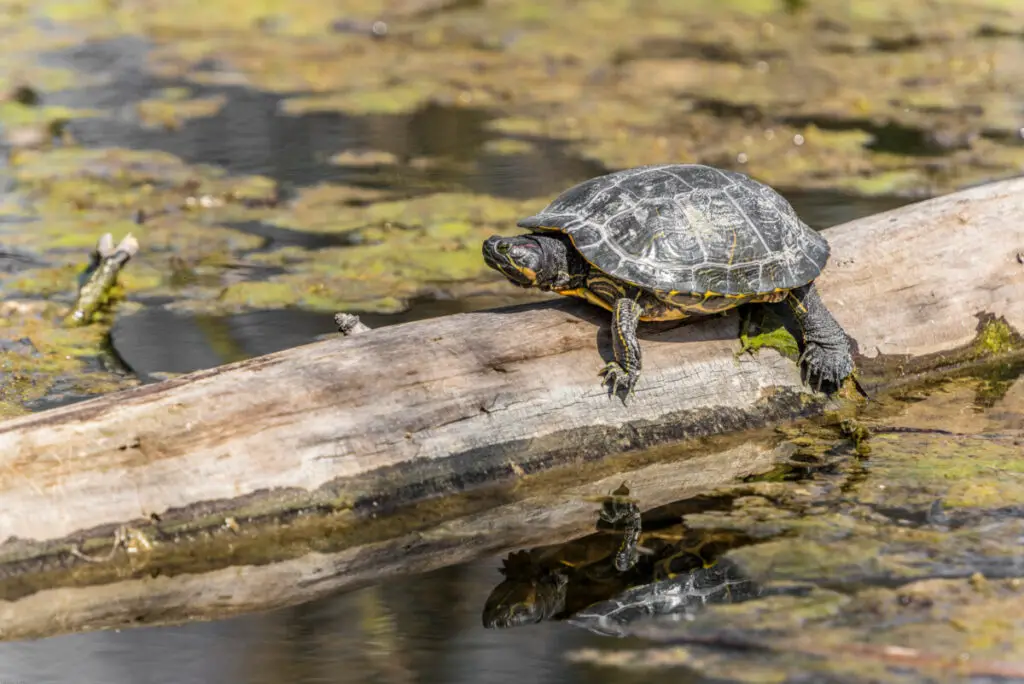
We start with the most common turtle found throughout Michigan state. The Midland painted turtle is small to medium-sized. It measures between 5 to 9 inches when mature. Scientifically known as Chrysemys picta marginata, this turtle has dark brown to black shell and dark skin color.
Its shell has red markings on the sides, while the limbs and the head have red and yellow stripes. The shell’s lower part is yellow. Midland painted turtle is mainly found in freshwater bodies with slow-moving waters like marshes, ponds, swamps, creeks and rivers.
These turtles frequent areas with basking sites such as logs, shorelines, or protruding rocks. During winter, they hibernate at the bottom of water bodies or inside submerged undercut banks.
As with all other painted turtles, this species is omnivorous. Thus, the turtle feeds on plants and meat, especially small vertebrates such as frogs and fish. The turtle has a lifespan of between 20 and 30 years which is a medium for a turtle.
Midland painted turtles nest between late May and early July. Nesting happens in soil with either sand or gravel within a distance of 200 m from a water body. The females reproduce every year and may lay multiple clutches at a given time. A clutch contains between 3 and 14 eggs.
The sex of the hatchlings depends on the temperature during incubation. Hatchlings of painted turtles have anti-freeze adaptations that enable them to survive in sub-zero temperatures.
Turtle’s eggs face the threat of predators, especially raccoons, skunks and foxes. Human activities such as illegal turtles’ collection as pets or for food is a great danger to the decline of Midland painted turtles’ population.
2. Blanding’s turtle
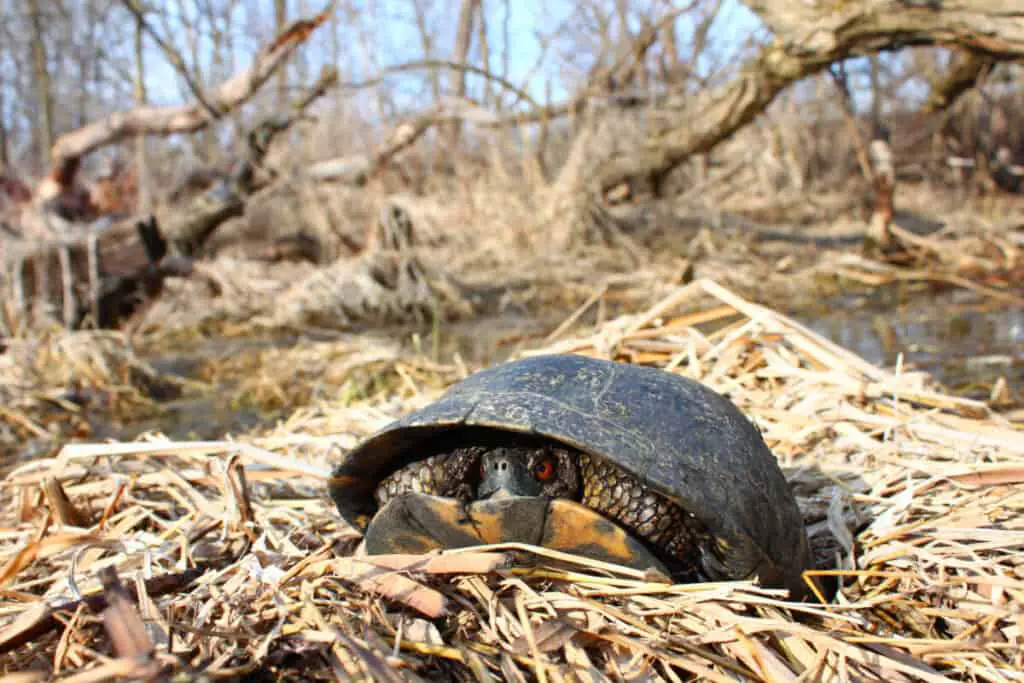
Blanding’s turtle is one of Michigan’s special concern species because of the threat to the turtle’s marshy habitats that have been interfered with by developments and roads. However, the turtle is not listed as an endangered species.
It is distinct due to its very long mustard yellow neck and helmet-shaped shell.
The top part of the shell is colored dark brown to black with yellow spots and streaks. The lower part is yellow with black patterns and black blotch and the corner of the scutes. Other than the uniquely mustard-yellow neck, the skin is dark brown.
Measuring between 7 and 10 inches, this turtle is medium-sized. They live in habitats with shallow clean waters with a lot of vegetation. The turtle’s common aquatic homes include common in marshes, bogs, ponds, creeks, shallow lakes, and lake inlets.
The turtles also inhabit terrestrial environments in spring and summer, during which they mate and nest. Nesting happens between late May, and mid-July and their eggs have a 70-90 days’ incubation period.
Unlike most turtles, Blanding’s turtle does not rely on water to swallow. Their lifespan is between 60 and 80 years. This makes it one of the native Michigan turtle species with the longest lifespans.
Just like with the other turtles, the sex of the hatchlings depends on the temperature during hatching. This turtle species with a permanent grin appearance is omnivorous. If you seek to keep this reptile as a pet, it will cost you $300 -$450 to buy one.
The scientific name of Banding’s turtle is Emydoidea Blandingii.
3. Common Map Turtle
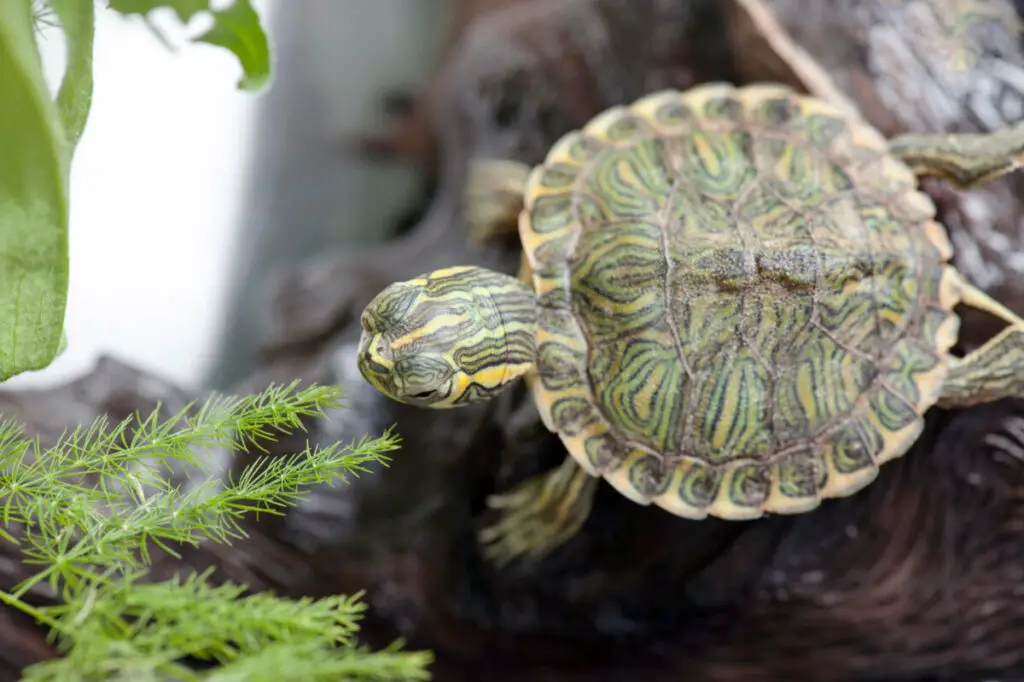
The common map turtle has a dark brown to a black shell. The upper part of the shell, known as carapace, has a map like pattern-like, hence the name common map turtle. A unique feature of the turtle is a ridge that runs from the front to the back of the shell.
Another unique feature of the turtle is the two light-colored stripes on its head. Its shell and skin colors on the shell fade as it ages. This turtle measures up to 10.5 inches when mature, with the females being bigger than the males. In most cases, the males only attain a 6-inch length.
Common map turtle has a lifespan of between 30 and 50 years. They are also some of the most common turtle species in Michigan.
These turtles are aquatic and often occupy slow-moving or stagnant waters bodies that have plenty of vegetation. So they are common in lakes, ponds, streams and slow-moving rivers. They are great swimmers and often bask not too far from the water bodies.
Being omnivorous, the Common Map turtle mainly feeds on frogs, crayfish, aquatic insects, freshwater mussels and aquatic vegetation. They, however, eat more meat than plants.
Overwinter, these turtles hibernate in slow-moving water bodies. The main predators of the adult Common Map turtle are coyotes, skunks, foxes, opossums and raccoons.
As for hatchlings, the main predators are raccoons, crows, skunks, gulls, and grackles. The scientific name for the Common Map Turtle is Graptemys geographica. For a pet, the turtle costs between $20 and $60, depending on whether it is a juvenile or an adult.
4. Common Musk Turtle
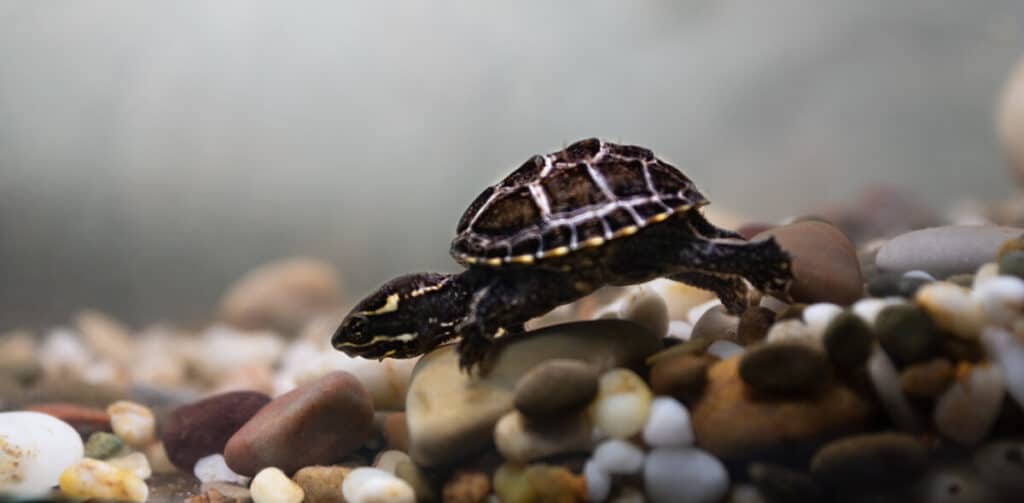
This turtle is also referred to as the Stinkpot turtle because the musk glands emit a foul-smelling liquid when the reptile is threatened. It is also known as the Eastern Musk Turtle and has a lifespan of about 50 years.
With a dark grey and, at times, black shell, this turtle perfectly camouflages its muddy environment. Their shells are unmarked. The dome-shaped shell gets flat as the turtle ages. A unique feature is the two lines running from its neck to nose that are yellow or green.
Sternotherus Odoratus, as they are known scientifically, the Common Musk Turtle is one of the turtles that remain small. They measure between 3 and 5 inches when fully mature.
This is a beginner-friendly turtle choice for any aspiring pet turtle owner. They are easy to manage and remain small as they only reach a maximum length of 5 inches when mature. The price of a Musk turtle ranges between $20 and $90.
As poor swimmers, these turtles do not chase their prey. They use scents for hunting and mainly feed on tadpoles, mollusks, crayfish. Since they are omnivorous, the turtles also feed on aquatic vegetation.
5. Red-Eared Slider Turtle
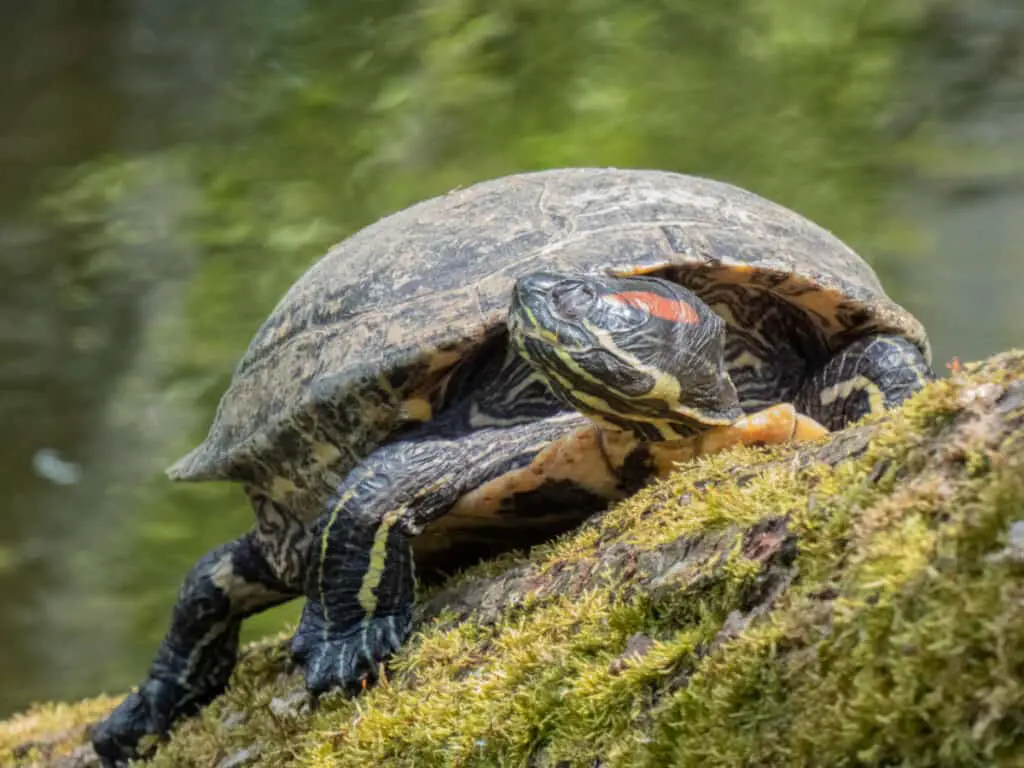
This turtle gets its name from the red lines behind its eyes. The lines may be orange or, on rare occasions, yellow. The turtles’ skin colors brown or black, and it is covered with yellow stripes. When it comes to the shell, it is either dark brown or black.
The red-eared slider is one of the most popular pet turtle species. Part of the reason it is preferred by most pet owners is because of its small size, even when mature. The turtle only grows to between 6 and 8 inches.
Other reasons as to why the red-eared slider is a favorite pet turtle include its docile character and distinct markings.
Also known as the Red-eared terrapin or Water Slider turtle, this reptile is scientifically referred to as Trachemys Scripta Elegans. The semi-aquatic turtle is common in creeks, ponds, marshes and slow-moving streams with fresh and warm water. It has a lifespan of between 30 and 40 years.
These turtles frequently bask alongside water bodies’ edges and can be at times seen stacking up against each other.
The red-eared slider is omnivorous. It nests between early March and late June. Its eggs take about 75 days to hatch. The sex of the hatchlings varies depending on the incubation temperature.
A juvenile red-eared slider costs about $20, with an adult one costing as high as $50.
6. Eastern Spiny Softshell
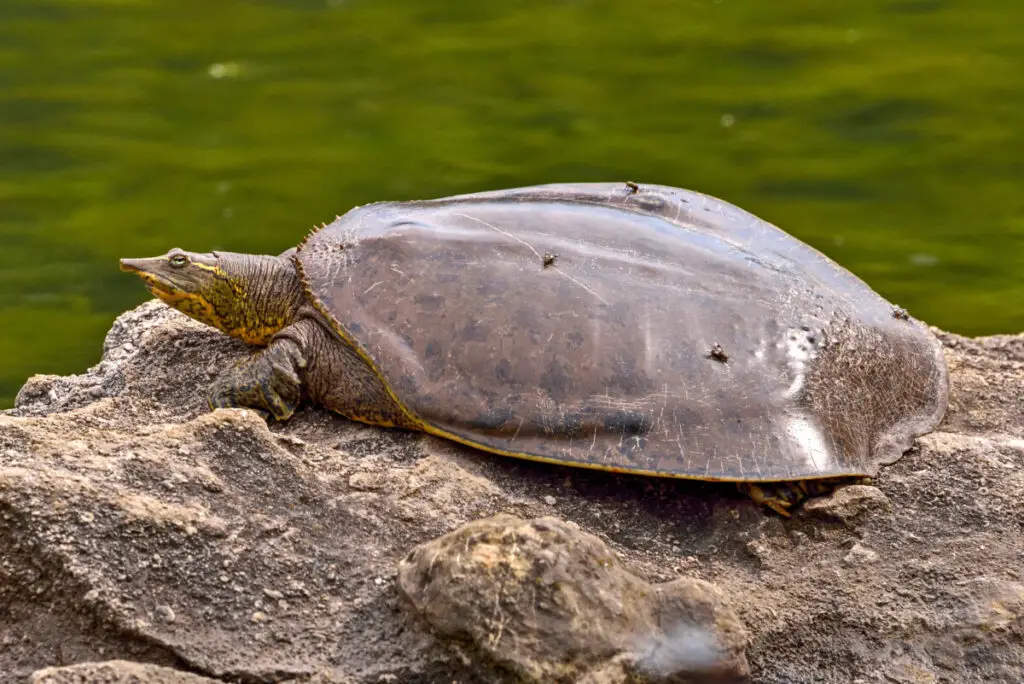
The Eastern Spiny Softshell is the only Michigan turtle with a soft carapace that has no scutes. Its shell has a rubber feel and is covered with skin. Besides, it looks like a pancake and bears dark spots. The name of this turtle comes from the tiny spines at the front part of its shell.
A male adult Eastern Spiny Softshell measures 9.5 inches while the female measures about 17 inches. With a lifespan of between 20 and 50 years, this turtle will make a long-term companion should you choose to have it as a pet.
Spiny Softshell turtle is common in open habitats with muddy, sandy bottoms and minimal vegetation. They spend most of the time in dry areas basking and looking for food. These turtles nest in sandy areas near water bodies.
With long tubular beaks, the turtle can cause serious injuries by biting if touched. The main predators of adult spiny softshell turtles are human beings, while for juvenile ones, the predators are many, including foxes and raccoons.
In terms of reproduction, the turtle nests between March and June. The eggs stay for about 80 days before hatching.
Scientifically known as Apalone Spinifera, this turtle lives between 20 and 50 years. The turtles are quick to hide upon spotting a predator. For this reason, they are hardly seen. They have webbed feet that enable them to swim in the water quickly.
Eastern spiny softshell turtles are carnivorous and mainly feed on mollusks and invertebrates. If looking for a pet, these turtles are only ideal for intermediate to experienced pet turtle owners. The price ranges between $70 and $250.
7. Common Snapping Turtle
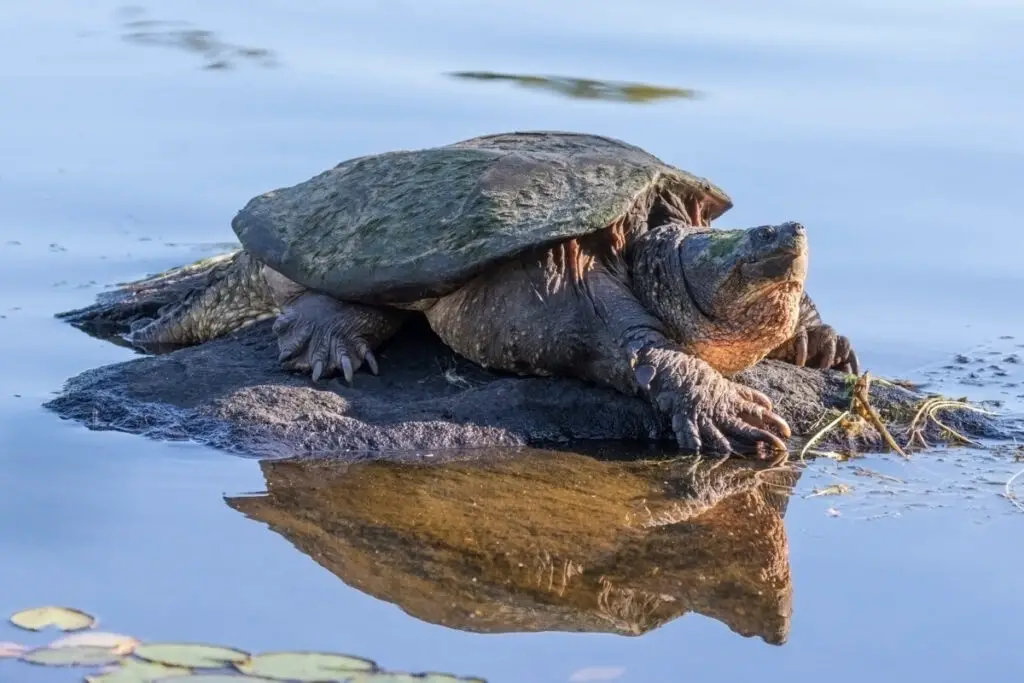
Common Snapping Turtles are aquatic turtles with a strong beak-like mouth. They are the largest turtle species in Michigan. Their necks, tails and legs are often very long. Older turtles have smoother shells, and the smoothness increases as the turtle grow older.
Other names used to refer to the Common Snapping turtle are Common Snapper, Snapper or Eastern Snapping turtle. The scientific name for this turtle is Chelydra Serpentina.
In terms of size, its length ranges between 12 and 19 inches, and they weigh 10 to 35 pounds. Smooth flowing freshwater with muddy bottoms is their preferred habitat. Unlike other turtles, they hardly bask in the sun. Instead, they bask by floating on or below the water surface.
Since they cannot retract their limbs, tail and head inside their shells, the turtles use their strong jaws as a defense mechanism. They are very aggressive, especially outside water and can bite and hiss if they spot predators.
Common snapping turtles can live for 30-50 years. As omnivorous reptiles, they mainly feed on aquatic vegetation and several vertebrates and invertebrates. Their mating occurs between April and November, while nesting occurs in May, June and July.
Females can lay up to 80 eggs, and the eggs take 9 – 18 weeks in incubation. Hatchlings have many predators, including herons, skunks, raccoons, snakes, crows and mink. On the other hand, adults have few predators, and most are hit by vehicles when moving from one water body to another.
8. Eastern Box Turtle
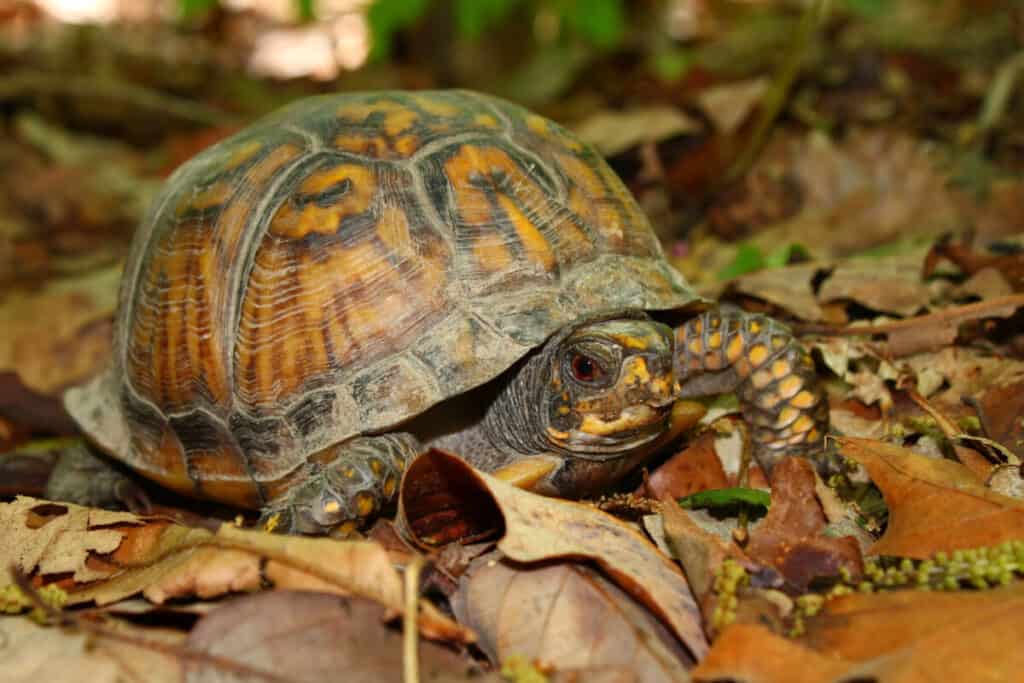
Eastern box turtles are a species of concern in Michigan. Common in the Southwest parts of Michigan, they are the only terrestrial turtle found in Michigan. The name Box turtle comes from their ability to retract their tail, head and limbs inside the hinged shell forming a box shape.
The Eastern Box turtle is scientifically known as Terrapene carolina carolina.
Distinctly, these turtles can regenerate their hinged shells. The carapace has unique orange and yellow markings and forms a high-doom shape. On the other hand, the plastron is dark brown.
These turtles grow to a length of 4 to 7 inches making them quite small even when mature. Woodlands, grasslands, marshes and parts near ponds and streams are the most common areas where these turtles inhabit.
Mating happens between April and October. Nesting occurs between May and July, and a female box turtle lays one clutch in a year. A clutch contains between 2 and 8 eggs, and incubation takes up to 3 months, depending on the soils’ moisture level and temperature.
As pet turtles, they make an ideal choice for a beginner. A baby Eastern Box turtle costs a minimum of $120, while an adult cost up to $400.
9. Wood Turtle
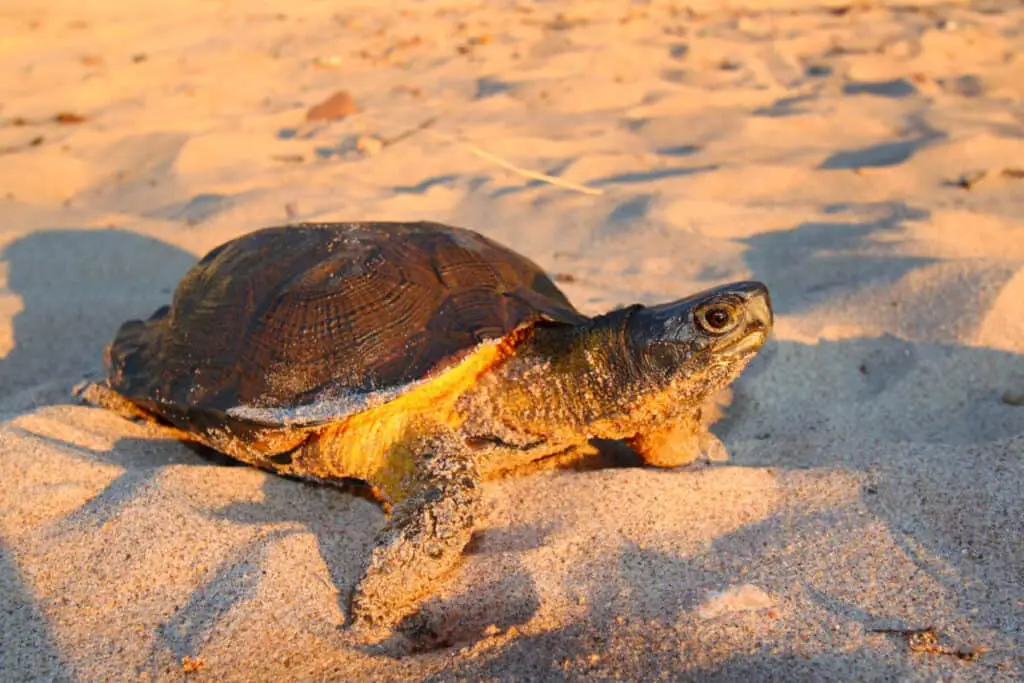
The doom-like upper part of this turtle’s shell is brown, while the lower part is yellow with dark irregular patches. Wood turtles’ heads and limbs upperparts are brown or black. On the other hand, the lower part of the limbs, neck and other skin areas are either orange or yellow.
They are named wood turtles because of their rough shell that has a texture that feels like wood. Their shells have patterns like those of wood grain and growth rings.
Being quite intelligent, they rock themselves in the soil and create vibrations to trick worms into thinking that it is raining. These turtles mainly feed on earthworms, snails, slugs, mollusks, blackberries, raspberries, strawberries, blueberries, and plants as omnivores.
They remain active in the daytime while looking for food.
Wood turtle species are of special concern in Michigan. This is because they are largely declining in numbers, and most are hit on roads when crossing to other water bodies. Glyptemys insculpta, as they are known scientifically, mainly inhabit ponds and woodland.
They have about 40 years’ lifespan in the wild, while in captivity, their lifespan is about 60 years. Wood turtles grow to a length of between 5.5 inches and 8 inches. Their weight ranges between 1 and 3 pounds.
Nesting happens between May and July, and on average, a clutch contains between 6 and 8 eggs. Incubation takes 80-100 days. Their eggs are threatened by predators such as foxes, skunks and raccoons.
10. Spotted Turtle
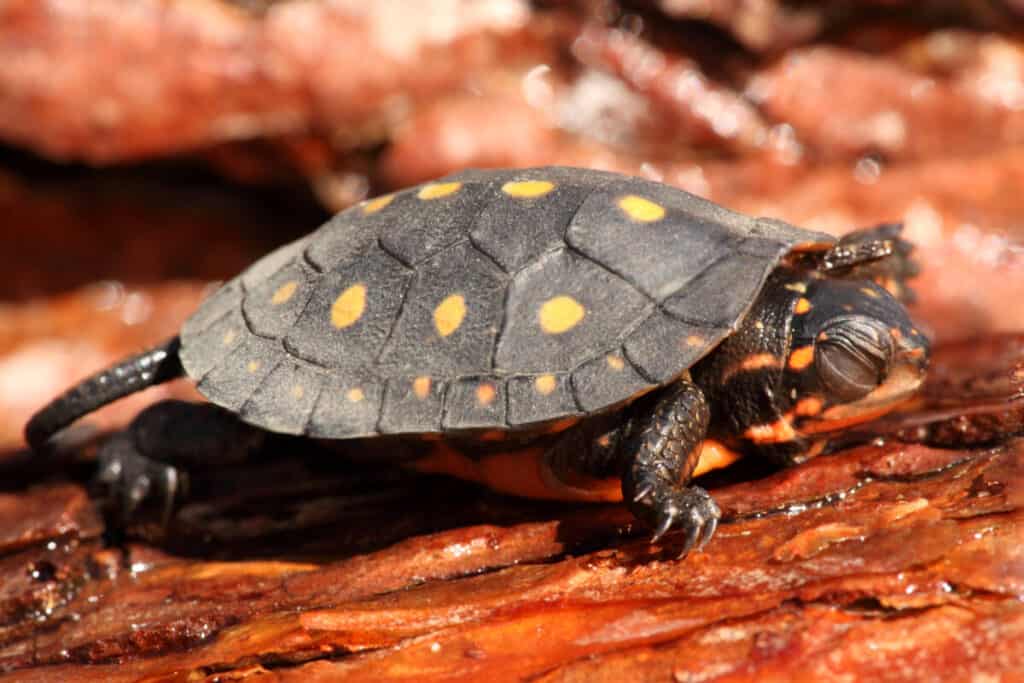
Lastly, we have the spotted turtle that is a threatened species in Michigan. This is a result of massive interference with their natural habitat. In addition, some people collect these turtles from the wild for pets, largely contributing to the decline of their population.
As the name suggests, the turtle gets its name from the tiny yellow spots on its dark upper shell. The lower part of the shell is yellow. Its head is dark with some yellow spots and, at times, yellow parts on both sides of the head.
They are hardly seen since they survive in small populations in a few parts of Michigan. Spotted turtles are some of the smallest turtle species, only attaining a length of about 4.5 inches when mature.
The maximum recorded length of a spotted turtle species is 5.4 inches.
When it comes to habitat, they live in flooded forests, marshes, bogs and wet meadows. Nesting happens between May and June, with the females laying only one clutch. A clutch contains between 1 and 8 eggs. Females search for open areas with well-drained but moist soils.
Hatchlings sex depends on the nesting temperature in the second third of the incubation period. Incubation takes between 44 days and 83 days. This period is shorter when temperatures are warmer.
Temperatures between 23 degrees Celsius and 27 degrees Celsius produce more male spotted turtles. On the other hand, warmer temperatures of about 30 degrees Celsius produce females only.
These semi-aquatic turtles have a lifespan of 25-50 years. For a pet, a juvenile spotted turtle costs about $70, while an adult one costs $100.
How to Protect Michigan Turtles
All the 10 Michigan turtle species play an important part in the state’s ecosystem. They create habitat for smaller animals because of the burrows they form, circulate nutrients between land and water bodies, act like prey and predators in food webs, helps in the growing of flowers and plants and flowers through the distribution of faeces.
Some of these turtle species have been declining in numbers mainly due to human interference with their natural habitat. These interferences include pollution, predation of nests, wetland drainage, and over-harvesting.
Here are ways in which we can all play a part in preserving the three turtle species of concern and the one threatened species native to Michigan.
1. Public Education
One of the most important ways of protecting species of concern and the endangered ones is by educating the public on these turtles’ main habitats. As such, people will know how to protect these habitats and allow the reptiles to thrive. Public education will also equip people with knowledge on how to identify them.
If you find a turtle on the road, move it towards the direction it is walking. Since handling some turtles, such as the Snapping turtle, use a shovel to move the reptile. Avoid dropping the turtle because if injured, the turtle may take a long to heal.
In our detailed analysis above, we have shared the general appearance and unique features that would help you distinguish these turtles.
2. Conservation Efforts
Another effective way to protect these threatened and special concern turtles is to set up or join turtle-related conservation organizations. These organizations work to protect the interfered with habitats of these animals.
Participating in water bodies clean-ups and reducing the disposal of plastics will also help. Using reusable bags and bottles also goes a long way in addition to not littering the environment.
Conclusion
Michigan native turtles are diverse. Some remain small while others grow moderately big. Some have long lifespans of up to 60 years, while others have a shorter lifespan of between 20 and 30 years.
Three of the 10 Michigan native turtle species have been declared to be of special concern. These three are the Eastern Box, Blanding’s and the wood turtles. Being of special concern means that these turtles need special protection actions.
Unfortunately, the Spotted turtle species are threatened and could become endangered if measures for protecting these turtles are not implemented.
The public should get educated on how to protect these turtles and conserve their environment. Supporting conservation organizations will also go a long way in preventing these turtle populations from continuing to decline.
We trust that having covered each of these Michigan turtles, you are now more informed on what makes each turtle unique, their reproduction patterns, habitats and their lifespan. Keep in mind that it is illegal in Michigan to take a turtle from the wild and keep it as a pet.